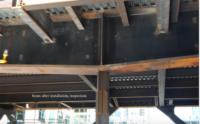Best of the Best Office/Retail/Mixed-use: One World Trade Center

Photo by Michael Mahesh, courtesy of PANYNJ
One World Trade Center’s 408-ft-tall steel spire, which sits atop the skyscraper’s 1,368-ft superstructure, makes the 1,776-ft-tall One WTC the tallest building in the Western Hemisphere and the fourth tallest in the world.
The spire was so unwieldy, the steel contractor broke the 758-ton structure into 17 sections for shipping. Each was barged into New York Harbor before crews trucked it to the site in lower Manhattan.
Spire transport and erection logistics are just two of the myriad design and construction challenges overcome by the team that built the 104-story office tower, which is the symbolic replacement for the original WTC’s 110-story Twin Towers, destroyed by terrorists on Sept. 11, 2001. Use of building information modeling for coordination and logistics saved $100 million, says Tishman.
As a consequence of 9/11, the 3.5-million-sq-ft One WTC is one of the most resilient office towers (ENR 8/15/11 p. 40). Redundancies abound. The air supply has biological and chemical filters. And life-safety systems, pressurized stairwells, a dedicated firefighters’ stair and an evacuation elevator for people with disabilities are inside a concrete core with 3-ft-thick walls.
One World Trade Center
New York City
Region New York
Project team
Owner/developer Port Authority of New York & New Jersey
LEAD DESIGN FIRM Skidmore, Owings & Merrill
GENERAL CONTRACTOR/CONSTRUCTION MANAGER Tishman Construction, an AECOM Co.
STRUCTURAL ENGINEER WSP
MEP ENGINEER Jaros Baum & Bolles






